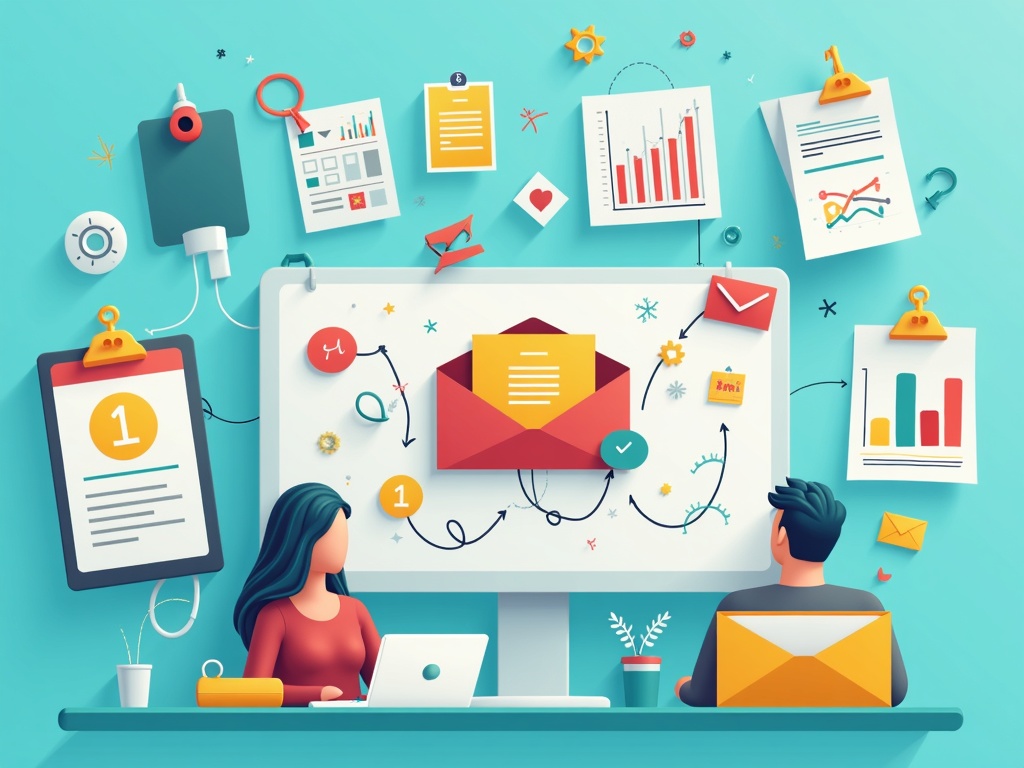How to Follow Up With Potential Clients: A Guide to Sealing the Deal
Imagine this: You’ve just had an amazing meeting with a potential client. The conversation flowed, they seemed genuinely interested in your services, and you left feeling confident. But days turn into weeks, and you haven’t heard a peep. Sound familiar? Don’t let a promising lead slip through your fingers. Mastering the art of the follow-up is critical to converting prospects into paying clients. It’s not just about being persistent; it’s about being strategic, helpful, and memorable.
Why Follow Up is Crucial for Landing Clients
Following up isn’t just a formality; it’s a fundamental step in the sales process. Here’s why it’s so important:
**Shows you care:A timely follow-up demonstrates that you’re genuinely interested in the client’s needs and value their business. It shows you’re proactive and reliable.
**Keeps you top of mind:Potential clients are often juggling multiple options. A thoughtful follow-up ensures your name stays fresh in their minds, especially when they’re ready to make a decision.
**Addresses concerns and questions:The initial meeting might not have covered everything. A follow-up provides an opportunity to address any lingering questions or objections the client might have.
**Reinforces your value proposition:Use the follow-up to reiterate the unique benefits you offer and how you can solve their specific problems.
**Provides opportunities to personalize the pitch:Shows the client you were actively listening and invested in meeting their goals. You can tweak and personalize your offer after discovering more about the client’s unique circumstances.
Crafting the Perfect Follow-Up Strategy
Before you even think about sending that first follow-up email, you need a plan. Here’s how to craft a strategy that gets results:
1. Define Your Follow-Up Timeline
There’s a sweet spot when it comes to timing. Too early, and you might seem pushy. Too late, and they may have already moved on.
**Initial Follow-Up (24-48 hours):Send a brief thank-you email within 24-48 hours of your meeting or initial contact. Reiterate your enthusiasm and briefly mention a key takeaway from your conversation. For example: “It was great speaking with you yesterday about [project]. I especially appreciated learning more about [specific challenge].
**Second Follow-Up (5-7 days):If you haven’t heard back after the first email, send a second follow-up. This is where you can provide more value, such as relevant articles, case studies, or a more detailed proposal.
**Third Follow-Up (2 weeks):If you still haven’t received a response, try one last attempt. Offer a different approach, such as a phone call or a brief summary of your key benefits. Express that you are happy to answer any questions, even if they aren’t planning on using your services at this time.
**The Break-Up Email (1 month):If all else fails, send a polite break-up email. This acknowledges that they may be busy and that you understand if your services aren’t the right fit. Leave the door open for future collaboration. The key is to be polite, professional, and avoid burning bridges.
2. Choose Your Communication Channels Wisely
Email is a standard for follow-ups, but don’t be afraid to explore other options. Consider your client’s preferences and the nature of your business.
**Email:Ideal for sharing detailed information, proposals, and resources. Keep your emails concise, personalized, and visually appealing.
**Phone Calls:Best for building rapport, addressing urgent questions, and closing deals. Be prepared with a clear agenda and be respectful of their time.
**LinkedIn:A great way to stay connected, share relevant content, and engage in industry discussions. Use personalized connection requests to build relationships.
**Video Messages:A more personal and engaging way to follow up. Record a short video highlighting your key benefits and expressing your interest.
**Text Messages:Only appropriate if you have prior permission or a more casual relationship with the client. Use sparingly for quick updates or reminders.
3. Personalize, Personalize, Personalize
Generic, cookie-cutter follow-ups are a surefire way to get ignored. Take the time to personalize each message based on your previous interactions and the client’s specific needs.
**Reference Specific Details:Mention something specific you discussed during your meeting or a challenge they mentioned. This shows you were paying attention and that you care about their unique situation.
**Tailor Your Message:Adjust your language and tone to match the client’s industry and communication style. A formal email might be appropriate for a corporate client, while a more casual approach might work for a startup.
**Offer Value:Instead of just asking for an update, provide something of value, such as a relevant article, a free consultation, or a customized proposal.
**Show Enthusiasm:Let your passion and excitement shine through. Clients are more likely to work with someone who is genuinely enthusiastic about helping them succeed.
What to Include in Your Follow-Up Messages
Now that you have a strategy in place, let’s dive into the specifics of what to include in your follow-up messages:
1. The Perfect Subject Line
Your subject line is the first (and sometimes only) impression you make. Make it count.
**Keep it short and sweet:Aim for 6-10 words.
**Personalize it:Use the client’s name or reference a specific topic.
**Create a sense of urgency:Use words like urgent, important, or deadline.
**Offer value:Highlight a benefit or a resource you’re providing.
Examples:
Following Up: [Project Name] Discussion
[Client Name], Ideas for [Their Challenge]
Quick Question About [Specific Topic]
2. Body of the Message
The body of your message should be concise, clear, and focused on the client’s needs.
**Start with a greeting:Use the client’s name and a professional greeting.
**Reiterate your purpose:Briefly remind them of your previous interaction.
**Provide value:Share relevant information, resources, or insights.
**Call to action:Clearly state what you want them to do next.
**Express gratitude:Thank them for their time and consideration.
**Sign off professionally:Use a professional closing and your contact information.
Example:
Hi [Client Name],
It was a pleasure speaking with you on [date] about [project]. I’ve attached a case study about how we helped a similar company, [company name], achieve [results].
Would you be available for a quick call next week to discuss how we can help you achieve similar results?
Thank you for your time.
Best regards,
[Your Name]
3. Call to Action (CTA)
A strong call to action is essential for guiding the client towards the next step.
**Be specific:Tell them exactly what you want them to do.
**Make it easy:Provide clear instructions and contact information.
**Create urgency:Encourage them to act quickly.
**Offer options:Give them multiple ways to respond (e.g., email, phone call, meeting).
Examples:
Schedule a call: [Calendar Link]
Reply to this email with your availability.
Download our free guide: [Link]
Common Mistakes to Avoid
Even with the best intentions, it’s easy to make mistakes that can sabotage your follow-up efforts. Here are some common pitfalls to avoid:
**Being too pushy:Don’t bombard clients with excessive emails or calls. Respect their time and space.
**Being too vague:Don’t send generic follow-ups that lack personalization and value.
**Forgetting to personalize:Tailor your message to each client’s specific needs and interests.
**Not providing value:Offer something of value, such as information, resources, or insights.
**Not having a clear call to action:Tell the client exactly what you want them to do next.
**Ignoring non-verbal cues:Pay attention to the client’s body language and tone of voice for cues on how to proceed.
**Giving up too soon:Don’t be afraid to follow up multiple times, but know when to cut your losses.
**Neglecting to proofread:Ensure your emails are free of typos and grammatical errors.
**Failing to track your follow-up efforts:Keep a record of your interactions and results to optimize your strategy.
**Making it all about you:Focus on the benefits for the client, not just what you want to sell them.
Advanced Tips for Follow-Up Success
Ready to take your follow-up game to the next level? Here are some advanced tips to help you stand out from the crowd:
**Use automation tools:Tools like HubSpot, Mailchimp, and FollowUpThen can help you automate your follow-up process and track your results.
**Segment your audience:Divide your potential clients into different segments based on their industry, interests, and needs. This allows you to tailor your messaging and offer more relevant value.
**A/B test your emails:Experiment with different subject lines, body copy, and calls to action to see what works best.
**Leverage social proof:Include testimonials, case studies, and client logos to build trust and credibility.
**Offer a free trial or consultation:Give potential clients a taste of your services before they commit to a long-term contract.
**Ask for referrals:If a client isn’t a good fit, ask if they know anyone else who might be interested in your services.
**Stay top of mind:Continue to engage with your potential clients even after the initial follow-up. Share relevant content on social media, invite them to industry events, and send them occasional updates.
Turning Follow-Up into a Habit
Following up effectively isn’t a one-time task; it’s an ongoing process that requires discipline and consistency.
**Schedule time for follow-ups:Block out specific times in your calendar to dedicate to follow-up activities.
**Create templates:Develop templates for your most common follow-up messages to save time and ensure consistency.
**Use a CRM system:A CRM system can help you track your leads, manage your follow-up activities, and analyze your results.
**Set reminders:Use reminders to prompt you to follow up with potential clients at the right time.
**Track your results:Monitor your follow-up efforts to see what’s working and what isn’t.
**Continuously improve:Always be looking for ways to improve your follow-up process and results.
Mastering the art of the follow-up is an investment that pays dividends. It transforms casual interest into concrete commitments, turning prospects into loyal, paying clients. By focusing on value, personalization, and persistence, you’ll not only close more deals but also build stronger, more meaningful relationships with your clients. So, go ahead, send that follow-up. Your next big client might be just an email away.





